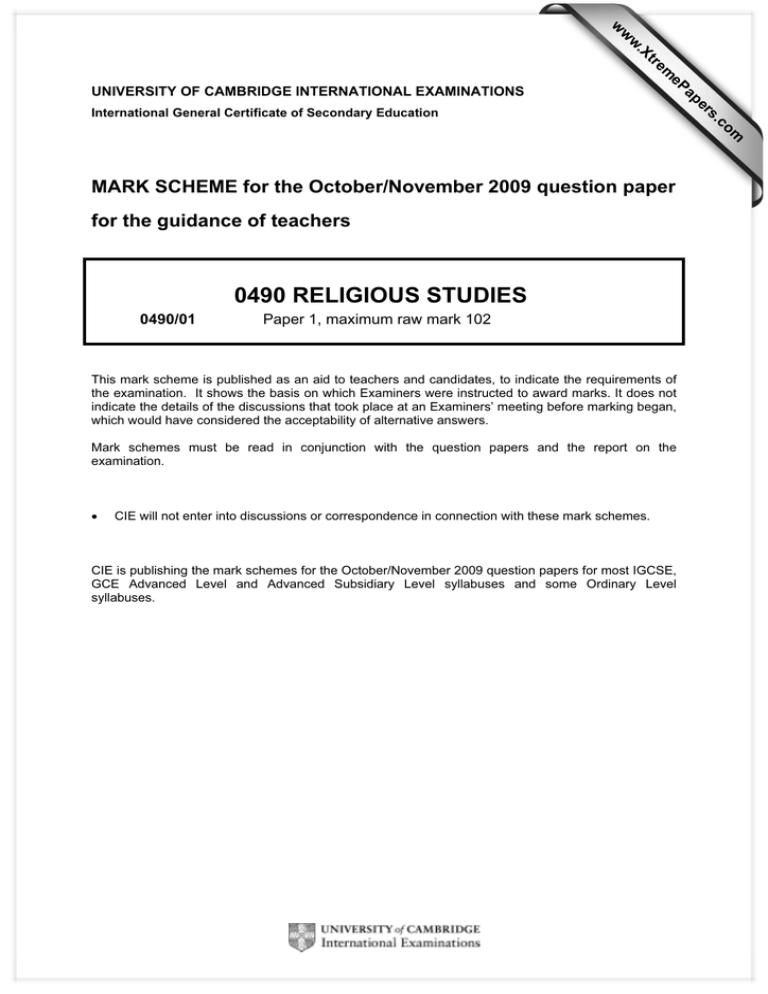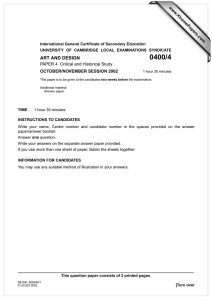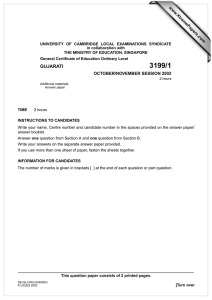0490 RELIGIOUS STUDIES MARK SCHEME for the October/November 2009 question paper
advertisement

w w ap eP m e tr .X w UNIVERSITY OF CAMBRIDGE INTERNATIONAL EXAMINATIONS for the guidance of teachers 0490 RELIGIOUS STUDIES 0490/01 Paper 1, maximum raw mark 102 This mark scheme is published as an aid to teachers and candidates, to indicate the requirements of the examination. It shows the basis on which Examiners were instructed to award marks. It does not indicate the details of the discussions that took place at an Examiners’ meeting before marking began, which would have considered the acceptability of alternative answers. Mark schemes must be read in conjunction with the question papers and the report on the examination. • CIE will not enter into discussions or correspondence in connection with these mark schemes. CIE is publishing the mark schemes for the October/November 2009 question papers for most IGCSE, GCE Advanced Level and Advanced Subsidiary Level syllabuses and some Ordinary Level syllabuses. om .c MARK SCHEME for the October/November 2009 question paper s er International General Certificate of Secondary Education Page 2 Mark Scheme: Teachers’ version IGCSE – October/November 2009 Syllabus 0490 Paper 01 Section A 1 CHRISTIANITY (a) What is a pulpit used for in a Christian place of worship? [1] Answers could include: place where the preacher stands to deliver sermons and talks; also accept place from which the Bible is read; used to enable the congregation to see and hear the preacher/reader more clearly. If it is clear from the answer that the candidate knows what a pulpit is, the mark should be awarded. (b) Name three religious objects that a Christian might use during a church service. [3] Wide variety of possibilities, such as: Bible, hymn book, prayer book, kneeler, rosary, cross, crucifix, lectern, bread, wine, chalice, font, baptistry, pulpit, altar, communion, table, Stations of the Cross. Accept answers which assume that the Christian referred to in the question is the preacher/priest. Accept symbolic objects that may be used to focus the mind, such as items of religious dress, icons or stained glass. No credit for objects which are used but which have no religious significance, such as the pews. (c) Explain why many Christians think it is important to belong to a church. [6] Mark according to levels of response. Ideas could include the chance to give and receive support in the Christian faith; the opportunity to learn from the preacher and hear the Bible explained; meeting with other Christians is recommended in the Bible; opportunity to confess sins; use of church for the Eucharist, for baptisms, confirmation, marriage and funerals; opportunity to set aside distractions of the week; opportunity for private prayer and public worship such as singing hymns; important to be part of worldwide Christian community. 2 ISLAM (a) What is the name of the Muslim festival that celebrates the end of Ramadan? [1] Id al-Fitr (accept alternative spellings, such as Eid ul-Fitr). ‘Id’ or ‘Eid’ on its own can be credited. (b) Give three features of this festival. [3] Credit any reasonable responses, which might include: lasts for three days; follows the giving of zakah; in mosque or open-air; parties, family gatherings; decorations; sweets; cards and presents exchanged; visits to cemetery. Don’t credit end of Ramadan. (c) Explain why this festival is an important celebration for Muslims. [6] Mark according to levels of response. Important to mark end of Ramadan, successful completion of time of self-discipline; thankfulness to Allah for blessings; important as a way of uniting the community; remembering prophet Muhammad’s time in the wilderness and his spiritual rewards; remembering the poor and sharing with them; remembering the dead; evokes sense of unity and brotherhood with Muslims around the world, past and present. © UCLES 2009 Page 3 3 Mark Scheme: Teachers’ version IGCSE – October/November 2009 Syllabus 0490 Paper 01 JUDAISM (a) What is the name given to a Jewish religious teacher? [1] Rabbi (other answers not acceptable) (b) Give three duties of a Jewish religious teacher. [3] Credit any reasonable and accurate response, which might include: giving advice on the interpretation of the Torah for daily life, for example about issues such as food preparation; preparing children to become Bar Mitzvah; teaching Hebrew; advising on legal disputes; counselling. (c) Explain why Jewish communities believe it is important to have religious leaders. [6] Mark according to levels of response. Importance for community of having people trained in the intricacies of Jewish law to settle disputes and to give advice. Need for leaders to give authority, to give spiritual guidance, to keep the people unified in their beliefs, to maintain traditions, to lead worship, to support a system of care for the sick and the elderly, to oversee the maintenance of the synagogue, to welcome strangers, to nurture the young, to support family life. © UCLES 2009 Page 4 Mark Scheme: Teachers’ version IGCSE – October/November 2009 Syllabus 0490 Paper 01 Section B In this section, answer both parts of two of the questions. 4 CHRISTIANITY (a) Describe a Christian funeral service. [12] Details could include: prayers for the dead and for comfort for the living, hymns and Bible readings, especially about resurrection and hope for the world to come. Candles to symbolise eternal life. Often a talk about beliefs and/or about the life of the person who has died. Body can be either buried or cremated. Words from the prayer book often refer to the resurrection of Jesus, and to the idea of returning to the dust from which Adam was made. Credit may be given for traditions particular to different parts of the world, for example the mourners wearing black, or white, as a sign of bereavement. Candidates might also mention practices that are particular to one denomination, such as a requiem Mass. Differences in practice between different Christian denominations could be explored, but these are not essential for full marks. (b) Explain how Christian funeral services remind people of Christian beliefs about death. [12] For high marks, candidates should demonstrate familiarity with Christian beliefs about resurrection after death, and eternal life in heaven or hell. Candidates could mention the belief that death is not the end, reflected in the Biblical readings; the belief that life is a gift from God and that humanity was created by God, reflected in the prayers, hymns and readings and in the ‘returning to the dust’; belief in hope and in eternal life, reflected in the lighting of candles and Biblical readings; belief in the resurrection of the body reflected in burial customs. 5 ISLAM (a) Describe the main features of a Muslim place of worship. [12] Credit should be given for the correct name, either mosque or masjid or both. Main features might include the minaret, the prayer hall, the dome, the mihrab, the qiblah, the minbar, the absence of pictorial art, the use of calligraphy, the facilities for washing, separate areas for men and women. Candidates can be credited for saying that the requirement is only for a clean place of prayer. The question asks for a description of key features rather than simply a list; a bullet-pointed list of features without attempt at explanation should not score above Level 2. For high marks, candidates should be able to explain the function of the features described. It is not necessary for candidates to include every feature in order to gain full marks. A Level 4 answer would probably describe at least three features. (b) Explain how the features of a mosque express important beliefs in Islam. [12] Ideas could include the representation of the meeting of heaven and earth in the architecture; the simplicity of decoration to represent tawhid and to avoid distraction from worship; the separate areas for men and women to illustrate their different roles and responsibilities in Muslim life; the large prayer hall to allow for unity in worship; the importance of facing Makkah and its significance in Islam; the minaret to facilitate the call to worship to encourage Muslims to meet their religious obligations. Other reasonable and accurate responses should be credited. © UCLES 2009 Page 5 6 Mark Scheme: Teachers’ version IGCSE – October/November 2009 Syllabus 0490 Paper 01 JUDAISM (a) Describe what happens in a Jewish home on the Sabbath (Shabbat). [12] Ideas could include: reference to the Sabbath as a weekly festival, taking place from sunset on Friday to sunset on Saturday. Candidates might recognise that different groups of Jews keep the Sabbath in different ways. Friday evening family meal, prepared in advance so that no work is done on Shabbat. Woman of the house lighting the candles and saying blessing; father’s blessing for his family. Day spent quietly with family and friends, opportunity to study the Torah and to talk about faith. Credit may also be given to candidates who give examples of what ‘resting’ means in practice, for example not driving a car, not undertaking any repair work such as sewing, not lighting fires or switching on electricity, not carrying objects from one building to another. Candidates could mention the havdalah ceremony to close Shabbat, with the spice box and plaited candle. (b) Explain why Jews believe it is important to keep the Sabbath as a special day. [12] Answers could include keeping Shabbat as a response to the commandments; a reflection of the belief that God rested on the seventh day, so that in remembering Shabbat Jews also remember their relationship to their creator; the need for a time of spiritual and physical refreshment; the celebration of freedom from slavery and of having the luxury of being able to rest because of the saving act of God; the importance of Shabbat in forming a bond between Jews around the world and a bond with Jews of the past. © UCLES 2009 Page 6 Mark Scheme: Teachers’ version IGCSE – October/November 2009 Syllabus 0490 Paper 01 Section C 7 (a) Describe what happens in a wedding ceremony in Christianity and describe what happens in a wedding ceremony in Judaism. [12] Candidates may attempt to answer by describing both ceremonies together, but for high levels they should show knowledge of the differences in practice between Christianity and Judaism. Answers might include that the ceremony is usually but not always held in a place of worship; the presence of family and friends; prayers and blessings; special clothes; exchange of rings. For Christianity, there might be reference to Mass in the Roman Catholic tradition, the exchange of vows in front of witnesses, prayers, and the blessing by the priest. For Judaism, candidates could refer to the chuppah representing the new home; prayers; the breaking of a glass to represent remembering sorrow even in times of happiness (such as the destruction of the Temple). As the question asks for a description of what happens in the ceremonies, details of social customs before and after the ceremony are not strictly relevant. Some credit may be given for such details, but higher marks should be for accurate description of the ceremonies themselves. (b) Explain why Christians and Jews believe that it is important for a marriage to begin with a religious wedding ceremony. [12] Candidates may take each religion in turn or they may give an answer about both religions together. Ideas could include the desire to have the marriage recognised by God; the desire for the marriage to be recognised by the rest of the religious community, who can offer their support in the years to come; making promises and commitments before God strengthens the marriage and gives focus for reflection in future life; sanction given to sexual relationship and the birth of children; following the example of Adam and Eve, part of the purpose of humanity as described in Genesis; religious marriage gives relationship best start with prayers and blessings; marriage made before God might make couple less inclined to separate without making an effort to sustain the marriage. 8 (a) Describe how Jews and Muslims use their sacred writings in their daily lives. [12] For each religion, credit should be given to candidates who can give the correct names to different texts and who show knowledge of their nature and origins, although this is not the main focus of the question, and candidates who do not have much detail about the nature of the texts should not be penalised. For both religions, answers could include reference to: using the sacred writings as a source of moral guidance and as a practical guide for rules such as food preparation; reflection on the sacred writings for spiritual growth and education, studying the texts and learning the original language; following the examples of respected figures such as prophets. Candidates might also refer to how the texts are handled, such as the stand used for the Qur’an. For high marks, candidates should show recognition of the texts as a source of authority. (b) Explain why Jews and Muslims believe that their sacred writings are more important than any other book. [12] In this answer, candidates could refer to the idea of revelation, and the belief that the sacred texts are the words of God and not just human constructs. They might refer to the revelation of the Qur’an to Muhammad, and the Jewish belief that God gave the words of the Pentateuch to Moses. Candidates could also consider ideas about sacred writings keeping a community together, providing moral guidance from God, providing role models and being a source of certain knowledge. © UCLES 2009



